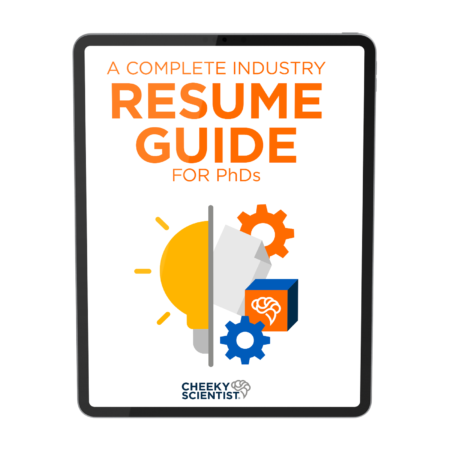5 Ways To Bomb A Perfectly Good Interview Presentation (And What Savvy PhDs Do Instead)

The first time I was asked to give a presentation as part of an onsite interview, I thought, ‘Well this should be a cake walk – I’ll just redo my defense presentation.’
I didn’t get the job.
And I knew that mid-way through my presentation.
To start, they had only scheduled 30 minutes for my presentation, yet the one I had prepared was an hour. I ended up speed talking my way through the entire thing. Mistake number one.
Mistake number two was not appealing to my audience. My presentation was highly technical, but my audience included people from R&D, finance, medical affairs, and production.
I could see their eyes glazing over a mile away.
Mistake number three was not communicating how my technical knowledge could benefit the company. Great – I knew all these techniques, but what did it mean for them?
The well-practiced presentation that is clean, simple, to the point, and appeals personally to the audience is the one that will land the job.
One Cheeky Scientist member recounts how their presentation got them an offer before they even left the building :
‘For my onsite presentation, I was asked to prepare some talking points as though I was speaking with a physician. They asked me behavioral and situational questions before we started the 15-minute presentation.
After that, they gave me some time to ask them questions.
I thanked them for their time. Then, as I was waiting for my ride after the interview, the hiring manager came out and said, ‘Congratulations! I am offering you the position!’
I had no idea what is going on! She said I did a great job, and she wants me on her team.
It was unreal!! I literally received a verbal offer 10 mins after my on-site while I was waiting for my uber to the airport!
Thank you, Cheeky Scientist, for helping me prepare for my onsite interview – I couldn’t have done it without you!’
Why An Onsite Interview Doesn’t Mean You Have The Job
In 2021, Tesla received an astounding 3 million job applications.
Yet, the number of employees working at Tesla only increased by about 30,000 between 2020 and 2021.
And Tesla isn’t the only company with a highly stringent hiring funnel.
Most companies receive around 250 applications for every job opening. Yet only 6-10 candidates are invited for a phone screen, and even fewer are asked to attend an onsite interview.
That’s because the hiring process gets really expensive at this stage.
On average, it costs around $4,700 to hire a new employee and much of this is incurred during the site visit.
This number is even higher for executive level positions – on average, it costs a company $14,936 to hire an executive level employee.
All this is to say, if you’ve been invited for an onsite interview, you’ve made it through the toughest section of the hiring funnel.
However, don’t assume it’s time to start envisioning your corner office. You still must convince them you’re the absolute best candidate for the position.
Many PhDs are asked to make a presentation during their onsite visit – and many PhDs bomb their interviews.
So, how can you avoid the same fate?
The answer is to prepare and practice.
Before your onsite visit, ask questions about the interview structure. Ensure you understand the format of the presentation.
Some companies want a 10-minute presentation while others expect an hour-long seminar describing your thesis work.
Also, understand your priorities. A good industry interview comes down to two root considerations: your purpose and your audience.
If you don’t keep these two very important factors in mind, you’ll end up with a less-than-stellar presentation.
5 Glaring Mistakes PhDs Make During Their Onsite Presentations
1. Creating a presentation that lacks a unified message
Think of a time you had to sit through a painful presentation. What was so agonizing about it?
Did it lack direction? Was it difficult to pinpoint the main message? Was it overly complex? All the above?
Think of how much you couldn’t wait to leave – how daunting and useless it all seemed.
Now imagine leaving your interviewers feeling the same way.
A good presenter will immediately let their audience know the purpose of their talk, and they’ll continue to circle back to that purpose throughout the presentation.
But what if you have several points to make?
You can still break up your presentation into several sections – you just need to ensure that each of your points still contributes to the overarching purpose or theme of the presentation.
While preparing your presentation, continually ask yourself, ‘Why am I giving this presentation? What is the message I want to convey to my audience?’
You want to clearly communicate what your audience will get out it. If they know the significance of the information, they’re more likely to remain engaged.
Many PhDs think they can just throw together a bunch of overloaded slides together and make up their presentation as they go.
But this isn’t a presentation – it’s merely an exploration of disconnected ideas. And it’ll be painfully obvious to your audience that even you don’t know the point of your talk.
And if you don’t know, how are they supposed to know?
An unorganized presentation is not only confusing; it’s disinteresting.
Who wants to put the extra effort into following a perplexing presentation? Also, how boring is it to sit through something you’ve lost interest in?

2. Having confusing or crammed slides
If you’re interviewing for a PhD-level position, chances are you’re in a room full of very intelligent people.
But you shouldn’t create a presentation that speaks to the smartest person in the room. You must cater to the lowest common denominator – the person without the technical expertise.
Your audience may be bright, but not everyone has the same background.
People in management won’t have a clue about quantitative modeling or whatever specialized niche you’ve decided to call home for the last 5-10 years.
Keep your presentation simple.
Each slide should contain one image and one point.
Studies show that if several points are made on a single slide, people will only remember one of those points. Or worse yet, none of those points.
Therefore, two messages are equal to zero messages.
If you’re presenting a multi-paneled figure that addresses several points, break up the panels. Put each panel on its own slide.
You also don’t want to overburden your slides with text.
Many PhDs love to fill every inch of white space with information. They do this because they want a crutch. Something to fall back on if they forget a point or lose their spot.
But this is guaranteed to overwhelm your audience.
If you require this crutch, then you haven’t practiced your presentation enough. Either that or you don’t know the topic well enough.
No matter the reason, you want to ensure that you can present without those added cues.
Don’t be the person that gets completely thrown off because someone didn’t hold their questions until the end.
[Side note: Holding questions until the end of a presentation is a very cultural thing – you may find that some companies don’t abide by this structure]
3. Not including engaging stories
Children are taught facts and lessons through song and stories. That’s because information is easier to retain when it appeals to our emotional center.
The same is true for adults. We just tend to forget this fact.
A well-told story is an impactful way to convey information for everyone. In fact, studies show that people tend to remember very little about a presentation, unless it included at least one story.
We can’t help it – our brains are attuned to receiving information in this way.
When we’re told straight facts, only a few discrete areas of our brain light up. Yet, when we’re presented with a story laced with facts, our entire brain lights up.
We begin to see ourselves as the protagonist of the story, and our brainwaves even begin to mimic those of the presenter.
This is called speaker-listener neural coupling.
Crazy, right? It may be crazy, but it’s also highly effective.
You may think there’s no room for stories in a scientific presentation, but this just isn’t true.
You don’t have to recreate the hero’s journey – you just need to contextualize the information in a way that people can relate.
If you’re working with patient data, share a treatment success story. If you’re in engineering, convey what your contributions mean for society.
Place the problem you want to solve into the context of their everyday experience.
There are many creative ways to catch your audience’s attention. Just find the one that speaks to you.

4. Not taking the audience’s needs into consideration
Your presentation isn’t only about you. In fact, I’d say it’s more about your audience than it is about you. When setting up your presentation, keep the interests of your audience at the forefront of your mind.
Let’s start with the ‘when’. When is the best time to present? It’s when people are least distracted, most awake, and least likely to be hungry.
There’s nothing worse than a hangry crowd.
You may prefer to wait until the late afternoon to present, but studies show that first thing in the morning and an hour after lunch are the best times to capture your audience’s attention.
And as weird as it sounds, studies also show that people are the most receptive to new ideas on Thursdays.
You may not have full control over when you present, but if you find that you’re scheduled for a less-than-ideal time, it never hurts to ask for a different time slot.
How you present the information should also cater to your audience.
Again, having slides packed with figures and text only serves to benefit you. No one is going to read your slides, and they certainly won’t retain anything from your presentation.
Another factor to consider is the size of the audience.
If you’re presenting to a larger audience that’s separated from you by a stage or an elevated platform, you’ll need to take this into consideration when it comes to your volume and your mannerisms.
If it’s a smaller audience, you won’t need to be as expressive, however, you’ll want to make the presentation more personal – ensure to make eye contact with each individual present.
Also consider who’s in your audience. You don’t want to miss the mark by referencing things that your audience doesn’t understand.
Ask yourself, ‘How would this audience best learn? What do they care about?’
Some things to consider is the average age of your audience, their professional background, their location, and their first language.
You don’t want to include a bunch of puns or culturally specific references that are going to fall flat.
You could give the best presentation of your professional life, but if it doesn’t appeal to who’s listening to it, it’ll fall on deaf ears.
5. Ignoring nonverbal cues
Many PhDs are afraid to look at their audience. They find a spot on the back wall and give their entire presentation to that spot.
As if that spot had a say in the hiring process.
But, to give a quality presentation, you have to read the room.
There is an ocean of nonverbal cues that can help you gauge how your audience is feeling, what they’re thinking, and let you know if you’re holding their attention.
Whether they know if or not, your audience will show you exactly how they feel.
Sounds odd, but if their head are straight and upright, it means that they’re not listening or engaged. If their heads are buried in their phones or computers, that’s also not a good sign.
However, if their heads a slightly tilted, they’re raising their eyebrows, and/or nodding, these are all signs of an attentive and curious audience.
If you find your audience drifting off, don’t panic. There are ways to reengage a sleepy crowd.
The easiest way to do this is to adjust your pacing and your intonation. Changing the speed at which you talk can reignite your audience’s interest – so can your tone and your gestures.
For instance, increase the enthusiasm in your tone; speed up or slow down your pacing; even add a few well-placed silences in the mix.
These minor shifts introduce novelty and can reignite you audience’s interest.
If you practice your talk enough, you’ll be able to easily adapt your style based on your audience’s nonverbal feedback.

Concluding Remarks
Most PhDs hate public speaking. But unfortunately, it’s a part of many PhD-level interviews. If you’re invited to an onsite interview that includes a presentation, go in prepared. Ask questions beforehand regarding the format. Find out what is expected of you. When developing your presentation, realize that more is less. You want one clear message, one theme, that is apparent throughout the presentation. Each slide should only have one talking point. Keep your slides clean, simple, and filled with white space. Know your audience and realize what is best for them – when you should present, what is important to them, and how they best learn. During your presentation, take note of your audience’s nonverbal cues. If you think you’re losing their interest, make minor shifts in your tone, mannerisms, and gestures. Overall, a good presenter is someone that is well-practiced, confident, to the point, knows their audience, and is adaptable. Presenting is a skill. And as always, practice makes perfect.
If you’re ready to start your transition into industry, you can apply to book a free Transition Call with our founder Isaiah Hankel, PhD or one of our Transition Specialists. Apply to book a Transition Call here.

ABOUT ISAIAH HANKEL, PHD
CEO, CHEEKY SCIENTIST & SUCCESS MENTOR TO PHDS
Dr. Isaiah Hankel is the Founder and CEO of Cheeky Scientist. His articles, podcasts and trainings are consumed annually by millions of PhDs and other professionals in hundreds of different countries. He has helped PhDs transition into top companies like Amazon, Google, Apple, Intel, Dow Chemical, BASF, Merck, Genentech, Home Depot, Nestle, Hilton, SpaceX, Tesla, Syngenta, the CDC, UN and Ford Foundation.
Dr. Hankel has published 3X bestselling books and his latest book, The Power of a PhD, debuted on the Barnes & Noble bestseller list. His methods for getting PhDs hired have been featured in the Harvard Business Review, Nature, Forbes, The Guardian, Fast Company, Entrepreneur Magazine and Success Magazine.
More Written by Isaiah Hankel, PhD































